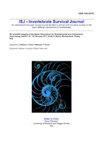铜绿假单胞菌碱性蛋白酶在激活大黄蜂幼虫抑菌活性中的作用
IF 1.2
4区 农林科学
Q4 IMMUNOLOGY
引用次数: 4
摘要
本文研究了铜绿假单胞菌金属蛋白酶-碱性蛋白酶在激活大黄蜂幼虫抑菌活性中的作用。体内实验结果表明,亚致死剂量的碱性蛋白酶通过诱导防御肽的合成,增强了大黄蜂幼虫血淋巴的抗菌活性。结果表明,金属蛋白酶和热杀铜绿假单胞菌对大肠杆菌的抑菌活性均在注射后4 h出现,注射后24 h达到最高水平,随后略有下降。在碱性蛋白酶和铜绿假单胞菌细胞处理后15 h和24 h的血淋巴中分别检测到对黑曲霉的抗真菌活性。我们还注意到,在血淋巴中存在金属蛋白酶诱导的抗菌活性水平高于注射铜绿假单胞菌后测定的活性。体外实验结果表明,蛋白酶攻毒或铜绿假单胞菌攻毒幼虫血淋巴中存在的诱导抗菌肽可被碱性蛋白酶消化。本文章由计算机程序翻译,如有差异,请以英文原文为准。
The role of Pseudomonas aeruginosa alkaline protease in activation of the antimicrobial activity in Galleria mellonella larvae
The role of Pseudomonas aeruginosa metalloprotease - alkaline protease in activation of theantimicrobial activity in Galleria mellonella larvae was investigated. The results of our in vivo study showed that injection of alkaline protease at a sublethal dose enhanced the antimicrobial activity in the hemolymph of G. mellonella larvae as a result of induction of defense peptides synthesis. We observed that the antibacterial activity against E. coli appeared in the hemolymph 4 h after the injection of both metalloprotease or heat-killed P. aeruginosa, reached the maximum level 24 h post injection, and next decreased slightly. Antifungal activity against A. niger was detected in the hemolymph 15 h and 24 h after the challenge in the case of the alkaline protease and P. aeruginosa cell treatment, respectively. We also noted that the antimicrobial activity level induced by the presence of the metalloprotease in the hemolymph was higher than the activity measured after the injection of the insects with P. aeruginosa. The results of our in vitro studies indicated that inducible antimicrobial peptides present in the hemolymph of protease- or P. aeruginosa-challenged larvae were digested by alkaline protease.
求助全文
通过发布文献求助,成功后即可免费获取论文全文。
去求助
来源期刊

ISJ-Invertebrate Survival Journal
IMMUNOLOGY-ZOOLOGY
CiteScore
2.10
自引率
0.00%
发文量
0
审稿时长
>12 weeks
期刊介绍:
Invertebrate Survival Journal (ISJ) is an international and open access journal devoted to prompt and innovative studies on the basic defense mechanisms in invertebrates, in particular with a view to identifying biotechnologies able to act against derived diseases and related economic damage.
Contributions will be mainly in the form of Letters to the Editor, Visions and Perspectives, Short Communications, Technical Reports, Research Reports, Review, Minireview and Reports of Meetings. Letters to the Editor can be commentaries or perspectives on invertebrate defence mechanisms or replies to the data published in ISJ.
 求助内容:
求助内容: 应助结果提醒方式:
应助结果提醒方式:


